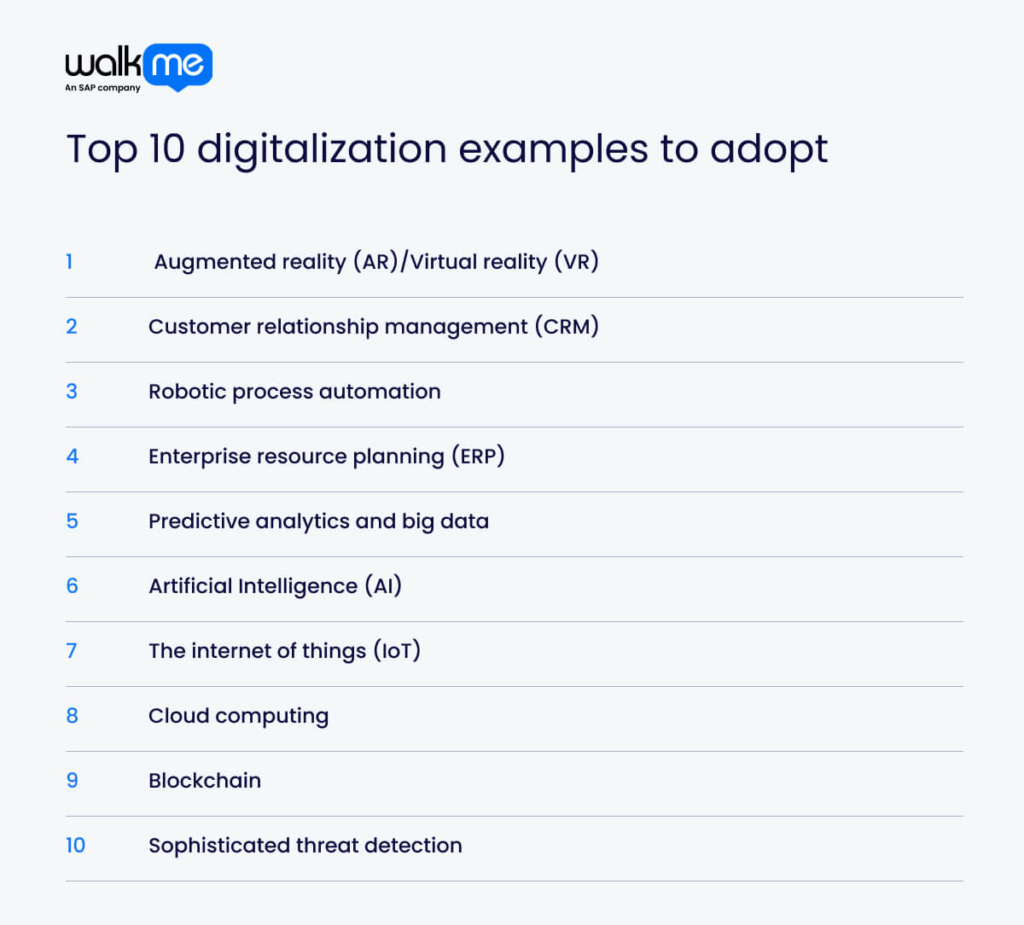Digitalization changes manual or analog processes into digital ones. This helps businesses work faster and smarter. It improves the customer experience, streamlines operations, and opens up new ways to earn revenue.
This can be through digital marketing, moving to cloud systems, or data analysis. It can also consider using online tools to connect with customers. Here, we’ll look at 10 examples of digitalization and how they add value to businesses.

Customer experience
Digitalization can drive a better customer experience through:
1. Augmented reality (AR)/Virtual reality (VR)
Augmented Reality (AR) and Virtual Reality (VR) are closely linked to digitalization as they improve the customer experience. They let users interact with digital content in new and exciting ways.
AR adds digital information, like instructions or 3D models, to the real world. Devices like smartphones let users see and use this digital content in their own space.
VR creates completely virtual worlds. It makes users feel like they are in a different place. This is useful for training, simulations, games, and more. For example, customers can use VR to explore a store virtually. They could also adopt AR to see what a building will look like when it’s finished.
So, AR and VR make the customer experience better and help businesses stand out. They help increase customer loyalty and engagement while boosting company profits.
2. Customer relationship management (CRM)
CRM systems are a big part of digitalization. They connect with other tools to give businesses a clear picture of how things are going. CRM systems help businesses by automating tasks and making workflows simpler. This makes digital transformation easier and more efficient.
With a CRM, businesses can track the customer journey. This includes the first contact, the sale, and how they interact after the sale. It provides a complete view of customer behavior and improves their experience.
CRM systems allow communication through email, text messages, social media, and live chat. This ensures smooth interactions across different platforms. They also automate tasks like sending out email campaigns, nurturing leads, and segmentation. This saves time and improves efficiency.
Websites, social media, and apps produce a lot of customer data. CRM systems also collect and analyze this data to understand customer behavior. Businesses can use this information to offer personalized marketing, product suggestions, and support.
Operational efficiency
A more efficient operations setup is also possible through digitalization by way of:
3. Robotic process automation
Robotic Process Automation (RPA) uses automation to handle repeatable tasks, like data entry. It works with different software to perform tasks between apps and businesses. RPA uses scripts to mimic what a person would do and then automates activities.
By automating routine tasks, RPA reduces errors, and increases productivity. This supports the goal of digitalization, which is to optimize processes. RPA can work with existing systems like CRMs, ERPs, and other software. In this way, it helps businesses adapt to changes in the market and customer needs.
RPA is also helpful for companies with older technology. It can work with these systems without needing to make major changes to the code. While RPA is a key part of digital transformation, it works best with other technologies. These include AI to handle more complex tasks.
4. Enterprise resource planning (ERP)
ERP systems give businesses a single place to find all their information. They collect data from every part of the company into one central database. This helps companies make smart decisions using up-to-date data.
Making things smoother reduces errors and makes things more efficient. It can also automate tasks like data entry, processing invoices, and creating reports. This saves time and reduces mistakes. This makes businesses more flexible and helps them adapt to changes.
Combining data from different departments also improves how the business runs and helps with decision-making. Real-time data lets businesses use advanced analytics and reporting to make better decisions. A unified view of customer interactions improves customer service and creates personalized experiences.
In short, ERP is essential for digitalization. It helps businesses optimize processes, make data-driven decisions, and adopt new technologies.
Decision-making
Digitalization can also compel better decisions through:
5. Predictive analytics and big data
Predictive analytics uses data from digital interactions to guess what might happen in the future. This helps businesses make better choices and run more smoothly.
Digitalization creates the data that predictive analytics needs. This allows businesses to make smart decisions based on what happened in the past.
With real-time data, predictive analytics gives quick insights. This helps businesses react faster to market changes. It also lets them personalize marketing and product recommendations. This improves customer engagement.
Predictive models can spot problems in systems and supply chains. This helps businesses fix issues before they become serious.
In digital marketing, predictive analytics finds customers who are likely to buy. This helps optimize ads and campaigns. In e-commerce, it helps recommend products, set prices, and personalize marketing. These models get better and more accurate as they get more data.
Predictive analytics also helps find new trends and needs. It helps guide strategic planning and how you use resources.
6. Artificial Intelligence (AI)
Artificial intelligence (AI) helps analyze data to make smart choices. It helps with digitalization by automating tasks and analyzing data in advanced ways. AI can quickly process huge amounts of data, finding patterns that people might miss. This leads to better decision-making.
By analyzing past data, AI can predict future trends, helping businesses plan and adapt. AI provides insights and recommendations to support better decision-making at all levels.
AI can also automate repetitive tasks, improving efficiency and reducing human error. It can also personalize products, services, and customer interactions based on individual data, creating a tailored experience.
Your business can use AI to power recommendation engines that suggest relevant products or content based on user data.
Connectivity and scalability
Digitalization improves connectivity and scalability for a business in the following ways:
7. The internet of things (IoT)
The Internet of Things (IoT) helps with digitalization by connecting everyday things like thermostats to the internet. This lets us collect and analyze data. This helps companies find patterns and make better decisions. It can also automate tasks, which changes how they do business.
For example:
- Smart electricity meters track how much electricity you use. They can then send the data to the company for accurate bills.
- Smart farming uses sensors to track fields. This helps farmers use water and fertilizer more efficiently.
- Smart garbage cans use sensors to measure how full they are and send updates to the waste company. This makes it more efficient to collect trash and save resources.
IoT sensors gather lots of data from the real world for digital analysis. This helps businesses automate processes, making them more efficient. It also lets companies track things in real-time. This involves getting instant updates on equipment status.
It can also help businesses improve customer experiences. They can collect data on customer preferences and personalize services.
8. Cloud computing
Cloud computing helps businesses update their technology. It makes it easier to use digital tools by offering flexible options without expensive computers. Companies can adapt quickly, create new programs, and meet market needs without managing their own hardware.
You only pay for what you use. This saves money and reduces the need for costly equipment that becomes outdated quickly. Teams can work together easily, sharing files and working from anywhere.
Cloud platforms are also very secure. They have automatic backups, AI to find threats, and ways to recover data if something goes wrong. Developers can quickly test new ideas and expand successful projects.
Security
Digitalization can also maintain the trust and security of your systems through:
9. Blockchain
Blockchain is a transaction ledger ideal for industries needing trust and traceability. It allows clear digital workflows, accountability, and stronger security.
Unlike traditional banking, blockchain leverages digitalization without a central authority. Transactions occur between users, giving them full control over their assets.
You can record every transaction on the blockchain in a public book that everyone can see. This makes it easier to see if anything is wrong and helps find fraud.
Once you record an entry, one cannot change or erase it. Special codes link records together to keep the data safe.
Blockchain can also keep users anonymous. Transactions are linked to special codes, not real names. Users keep their information private with special keys. But, the amount of privacy they have depends on the network.
These features make blockchain a reliable way to do secure digital transactions.
10. Sophisticated threat detection
Cyberattacks are a big problem for businesses and the world’s economy. Cybersecurity systems that use AI use digital technology to find these threats early.
They use machine learning to look at data from networks, what people do on computers, and what happens on the systems. This helps them spot things that look strange and could be dangerous.
These systems also:
- Stay strong during attacks: They can fix themselves, check for problems, and learn to deal with new threats.
- Learn from every attack: They get better at protecting themselves by using tricks like decoys to distract attackers.
- Find threats and survive attacks: Intrusion Detection Systems use special rules to find harmful actions.
One example is Endpoint Detection and Response (EDR). It monitors devices like laptops and servers and uses data to find suspicious activity and stop threats.
Utilize these digitalization examples on your road to digital transformation
Digitalization changes how businesses work. It makes communication easier and reduces mistakes with automation. Even more, it helps people make better choices.
To put in place a digitalization process using these examples:

- Understand where you are now.
- Set clear goals.
- Choose the right technology.
- Make a plan that fits your goals.
- Figure out how to put the plan into action.
- Get everyone on board with using the new tools.
In this way, you can make customers happier and your business more efficient.
FAQs
Digitalization transforms traditional business methods into digital processes, improving efficiency, data analysis, and customer interactions. It involves using tools like cloud platforms, IoT devices, and automation to streamline workflows and collect real-time insights. This shift enables businesses to operate more efficiently and connect with customers in personalized ways.

